Final report for FNE19-942
Project Information
This project sought to explore different methods of developing a productive vegetable field from a compacted gravelly city lot. One method involved the purchase and importation of topsoil and compost, and another focused on building soil from a raw form of organic matter in a new concept of the raised bed similar to Hugelkultur techniques. These raised Hugelkultur beds were created by laying straw bales end to end and adding wood chips in between them. Layers of topsoil and compost were added on top of the wood chips creating permanent raised beds with straw bales as the walking paths. Over the course of two growing seasons this field was compared to that of a simply built field with nothing but topsoil and compost. While the Hugelkultur beds had a much higher intial cost, after the two years of observations many benefits were found in the straw bale design. These included increased drainage and better protection from the possibly lead contaminated soil underneath. Long term benefits of increased soil health and fertility are also expected.
This project sought to compare methods of urban farm soil development through the VINES Binghamton Urban Farm expansion process. One method involved the purchase and importation of topsoil and compost, and another focused on building soil from a raw form of organic matter in a new concept of the raised bed. This led to a better understanding of developing healthy soil in the urban landscape without the need to import large quantities of foreign soil, while utilizing by products and waste products of urban land management and rural agricultural production.
Building healthy soil on a limited budget is a major challenge to growing food in an urban environment, as there is often unsafe levels of lead present or little to no existing topsoil post building demolition. Urban agriculture can play an important role in helping build healthy, local food economies. It has the potential to enlighten environmental stewardship, improve public health, and beautify marginalized or vacant land. However, overcoming the challenge of building safe, healthy soil is essential for urban agriculture to be more than a novelty, to be a real solution to food sovereignty and security, and to protect vulnerable populations from lead poisoning.
VINES’ Binghamton Urban Farm in downtown Binghamton, established in 2010, has undergone an expansion over the past two years. The Urban Farm teaches community members and youth about agriculture, nutrition, and environmental action while growing food for low-income families. Two new acres of land became available through a FEMA flood buy-out and the demolition of 12 properties contiguous with the farm. This land could not be used for any permanent structures and the City of Binghamton agreed to lease the property to VINES to expand the Urban Farm. Developing an urban farm usually requires the importation of resources to enhance the soil and increase productivity. In the case of the Binghamton Urban Farm, there was very little starting topsoil as it was scraped off the surface and used to fill in the foundations of the demolished properties. This topsoil was assumed to have high, unsafe levels of lead as this neighborhood was developed a century before lead was banned from paint and gasoline. The demolition company then added a few inches of a gravelly topsoil and compacted it with a bulldozer. Importing soil and compost to cover this compact surface and grow vegetables can have environmental costs and be financially prohibitive. Topsoil can be of varying quality, can be expensive, and is an extracted resource that can degrade the ecology of the site from which it is taken. Compost, while a renewable resource, can be of varying quality and is also expensive. To secure large quantities of either, one often has to have these resources transported from outside the local area. We sought to build healthy soil on the Urban Farm while minimizing negative environmental impacts and reducing costs by utilizing local raw materials as much as possible while experimenting with styles of raised beds. These beds were designed for commercial scale agriculture with the goals of maximizing the farm output, minimizing labor, and creating a sustainable system that will support production for many years.
Many other examples of urban agriculture deal with the issues of compaction, poor soil quality, and heavy metal contamination by building raised beds. Raised beds elevate the growing space to improve drainage, lessen compaction, allow ease of access, and minimize contact with contaminated soil. The quickest, most popular, and durable raised bed system is built with dimensional lumber, and then backfilled with a topsoil and compost mix. While this type of bed is good for community or home gardens, it is not ideal for commercial scale production. With
the increase in acreage at the Binghamton Urban Farm, lumber framed raised beds would have been very costly and wouldn’t be practical with current management techniques at the Binghamton Urban Farm, which utilizes a small walk-behind tractor to reduce labor and increase production.
One of the largest risks faced by urban agriculture is that of lead contamination in the soil. Lead is present in the urban environment from paint and gasoline before it was banned in both. Some research suggests that lead may not be as much of problem as thought. Brown et al. argues that the best urban farming practices are also the best practices to limit lead exposure. Nonetheless, lead is a hazardous material that can cause significant medical issues, particularly in pregnant women and young children. Lead exposure from urban soils has multiple vectors, including
plant uptake and ingestion, dust inhalation/exposure, and ingesting contaminated soil on produce. The National Sustainable Agriculture Information Service recommends dealing with low to medium lead levels by adding organic matter, lowering soil acidity, or covering contaminated soils with clean soil. Lowering the soil acidity can help immobilize the lead and lead to lowered plant uptake, and therefore less exposure thru eating contaminated produce. Washing produce can also go a long way to limit exposure by cleaning contaminated soil off. Finally covering the soil with clean soil or an organic mulch can do a lot to limit dust as well as limit contact to contaminated soil.
Another strategy for reducing toxic exposure is phytoremediation. This process utilizes plants or fungi to remove contaminants from soil. The plants/mushrooms grow, take up the toxins, and are then physically removed from the site and treated as a waste product. While this is useful for some heavily polluted sites, the EPA states that it is not a proven method and that many factors are at play during phytoremediation. As well, this method can take many seasons, and is not economical when trying to run an Urban Farm business with limited land availability.
Kyle Rittenburg is the former manager of the Binghamton Urban Farm. Kyle has a bachelor's degree in Sustainable Agriculture, and has worked at a variety of agricultural operations, including Johnny's selected seeds research farm and numerous other vegetable production farms. The Binghamton Urban Farm was founded in 2010 on two vacant lots in downtown Binghamton. As part of the non-profit organization Volunteers Improving Neighborhood Environments (VINES), the Urban Farm has been a learning and production space since its inception. Every year VINES runs a youth employment program that hires high school aged individuals for six weeks to learn about agriculture and the local food environment. These youth take part in all aspects of the farm's management as well as tour other local farms and businesses. While the youth are not on the farm, it is host to numerous volunteers that aid in the planting, weeding, and harvesting of produce that is sold thru another program VINES runs, the Binghamton Farm Share. The Binghamton Farm Share is a CSA program that partners with the Urban Farm and two other local farms to distribute CSA's, focusing on increasing access to fresh food for low-income families and individuals. In 2019 the Binghamton Urban Farm sold an average of 47 CSA shares a week, and in 2020 that number went up to 62 CSA shares a week. Produce is also marketed to local restaurants, the downtown Binghamton farmers market, and a new on farm stand. During the course of this project the Urban Farm grew from less than an acre to over two acres. Funding to help with this expansion also came from the Binghamton Mayor's office thru a Community Development Block Grant, as well as a Department of Environmental Conservation Environmental Justice grant.
Cooperators
- - Technical Advisor (Educator)
Research
During 2019 the Binghamton Urban Farm was given management of 12 new empty lots in the downtown area, 4 of which were vacant and 8 of which had homes on them. In November 2018 the city of Binghamton oversaw the demolition of the 8 houses. The house building material was taken to the local landfill and a bulldozer was used to scrap the surrounding topsoil into the basements of the foundations left behind. The demolition company then spread a few inches of topsoil and laid straw to protect it. Before this SARE funded project started, we prepared our first expansion field, "Soil Field" as follows. Soil samples where taken and tested for lead levels and soil nutrients. Starting from this compact surface, in January 2019 we built the Soil Field. The field measures approximately 3,360 square feet at 105 feet by 32 feet. The construction of this soil field was accomplished by using a small MT55 Bobcat bucket loader to layer approximately 4 inches of topsoil underneath 1 to 2 inches of compost. The soil was placed with the machine in long rows and raked by hand. Compost was then added on top of the topsoil without driving the machine over it to reduce compaction. In this way the field was built sequentially in 5 foot strips.
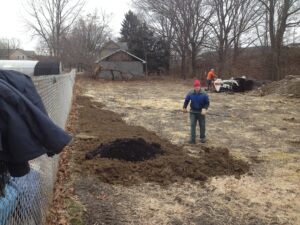
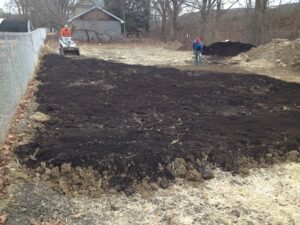
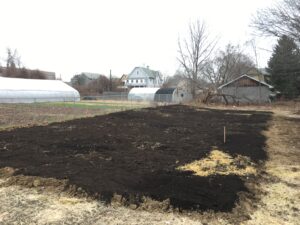
Following the preparation of the Soil Field, our SARE project proposal was accepted in February 2019 and we began construction on our experimental straw bale beds in the new "Hugelkultur Field" in April of 2019. The first two beds were constructed by hand during the Binghamton University Alumni Day of Service. Straw bales were laid out in rows 50 feet long, approximately 34 inches apart, just big enough for our BCS walk-behind tractor. The space inbetween bales was then filled with 6 to 8 inches of wood chips which was raked smooth, then layered with 2 to 3 inches of topsoil and 2 to 3 inches of compost.
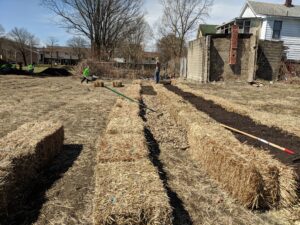
During the same work day in April we also organized the Soil Field into 50 foot beds with another 2 inches of fresh compost on top and a few inches of leaves in the walking rows.
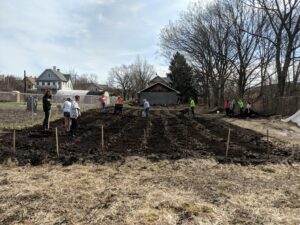
Following the April work day, the remaining straw bale beds were built over the course of the next few months with the help of rented equipment and volunteers. A New Holland tractor with a front bucket was rented to build some of the beds, and then a quicker and more efficient skid steer was rented to build the remaining straw bale beds. Wood chips were piled on the ends of the beds to create an incline that our BCS can drive up.
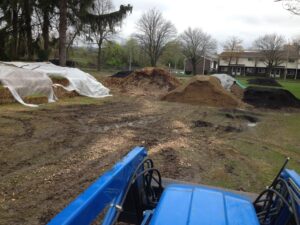
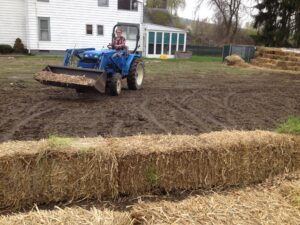
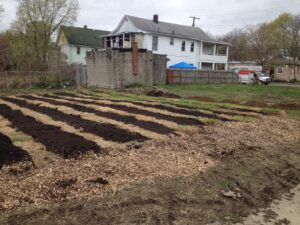
Most of the first 15 beds in the Hugelkultur Field and all of the Soil Field were planted during the second week of May 2019. Crops planted at this time in the Soil Field were carrots, beets, sweet potatoes, summer squash, cucumbers, and winter squash. Crops planted at this time in the Hugelkultur Field were parsley, head lettuce, cucumbers, green beans, sweet peppers, and tomatoes. Leaf lettuce was planted in both fields one month later in June. The leaf lettuce and cucumbers were planted with the intention of comparing the marketable yields of the same crops from the two different field designs. The leaf lettuce variety was Johnny's selected seeds Allstar Lettuce Mix, which was direct seeded with an Earthway seeder, in 3 rows per bed with approximately 8 inches between rows. The cucumbers grown were Marketmore 76, which were started as seeds in 38 cell flats on April 30, 2019, and transplanted into the fields in 1 row per bed with a 2 foot spacing between plants.
The leaf lettuce was harvested four times from each bed using a cut and come again technique. Cucumbers were harvested a total of ten times over the course of about six weeks.
Following the planting of the first 15 beds of the Hugelkultur Field, another 4 straw bale beds were added to the Hugelkultur Field and a third field Hugelkultur Field Two was constructed. Hugelkultur Field Two has 9 straw bale beds laid out in the same manner as the Hugelkultur Field, but utilizes a blend of wood chips and manure under the topsoil and compost cap. Hugelkultur Field Two was then planted mainly with fall brassicas including green cabbage, collards, napa cabbage, and swiss chard.
During the course of the 2019 season volunteer and youth employee impressions of the straw bale beds were noted as they were working in the field. We did not include questions regarding the straw bale beds on the youth employee end of the season surveys as originally planned.
Near the end of the season the strings holding the straw bales together were cut and removed from the field. Crops that were finished were mowed with a flail mower, the beds were worked with a power harrow and were seeded with a winter rye cover crop. Our garlic crop was also planted in the Soil Field in mid-October, and mulched with straw.
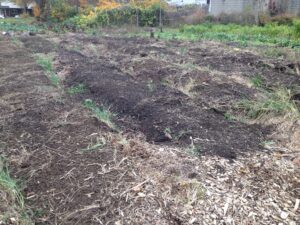
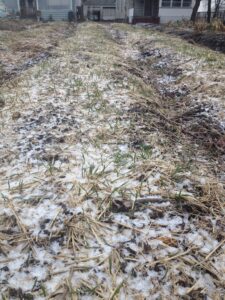
During the 2020 season the Hugelkultur fields and the Soil Field were brought into the larger farm management plan. As such they were treated differently specific to the crops grown in each. Nearly half of the Soil field was planted with Garlic in October 2019, the other half was lightly mulched with leaves. At the end of March a clear sheet of old greenhouse plastic was placed on the empty half of the Soil Field, weed seeds began to germinate and were plowed under with our rotary plow, while at the same time shaping raised beds to help with drainage issues observed in 2019. Weed seeds were allowed to germinate again and the power harrow was run over the raised beds to kill the weeds and prepare the field for transplants. The Hugelkultur fields were covered with black silage tarp in late March to kill the winter rye cover crop and the power harrow was run thru them to prepare for seeding and transplanting.
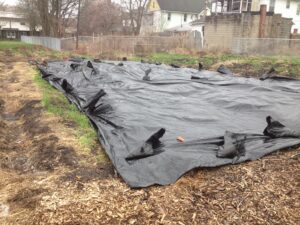
One of the biggest changes for management of the Hugelkultur fields in 2020 was that addition of irrigation. A city water hookup was installed right next to the field and allowed us to run drip line irrigation thru the entire field. In April crops planted in the Hugelkultur fields were potatoes, snap peas, carrots, and beets. In May summer squash and eggplant were added, green beans and basil followed in June. In August fall successions of lettuce and scallions, and our garlic crop was planted in the Hugelkultur beds in October.
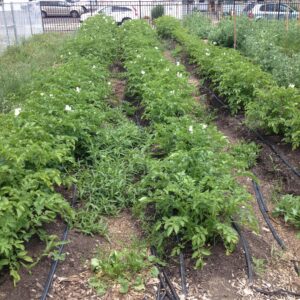
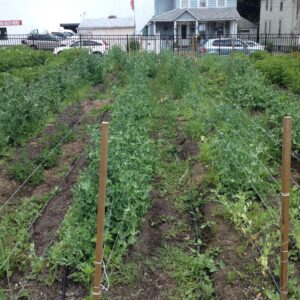
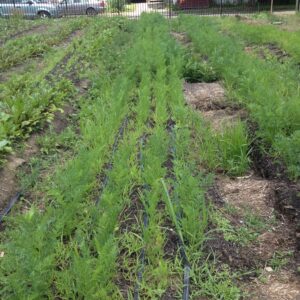
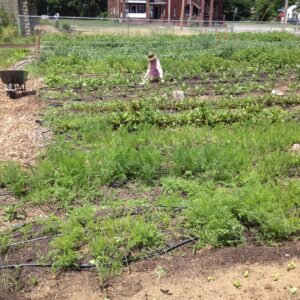
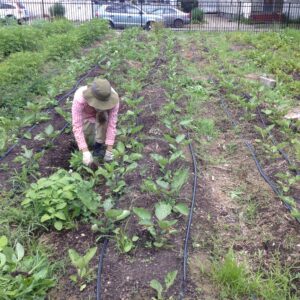
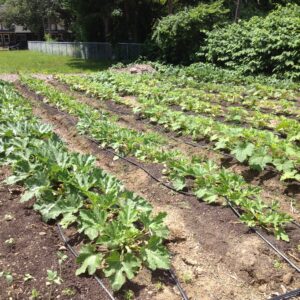
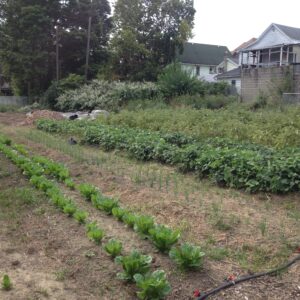
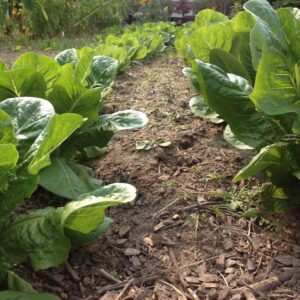
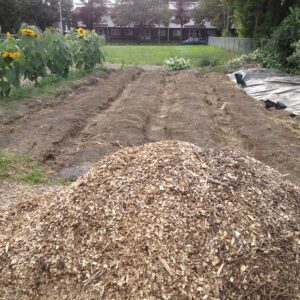
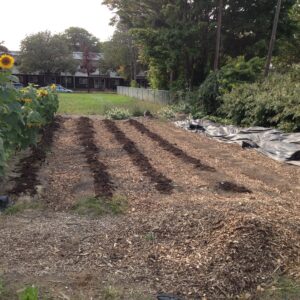
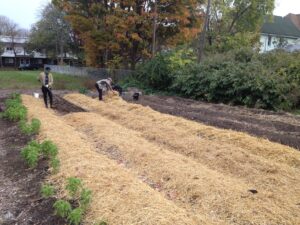
The Soil Field had multiple succession as well starting in April with broccoli, kale, and spinach plus the overwintered garlic from the fall of 2019. Summer crops of carrots followed the spinach, and fall arugula, radishes, and beets followed the broccoli. After the 2020 garlic harvest from the Soil Field, leaf lettuce was seeded in it's place. Winter rye cover was seeded in both fields in all empty beds in September.
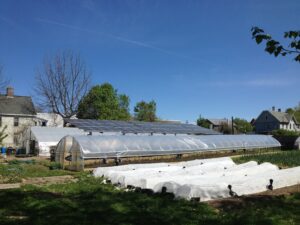
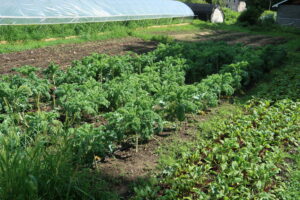
Over the course of the 2020 season various additions of organic matter and compost were added to both fields. Parts of both fields had both purchased and on-farm produced compost added to them. Both fields where mulched with chopped leaves in some of the paths and around some crops. The Hugelkultur Fields had wood chips spread in the walking paths as the straw bales continued to sink and decompose.
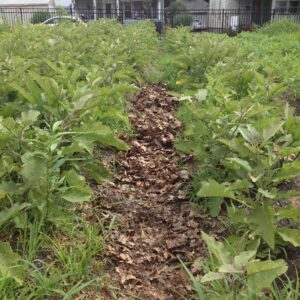
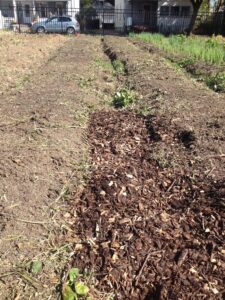
During the late Fall holes were dug in various locations to check the state of our decomposing organic matter underneath.
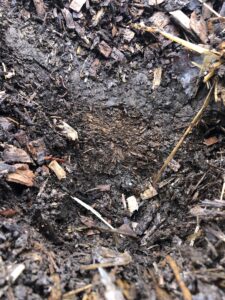
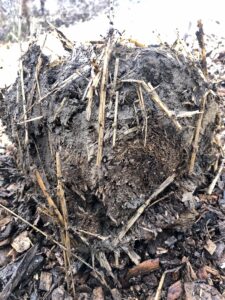
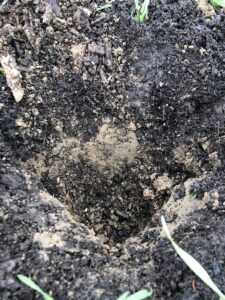
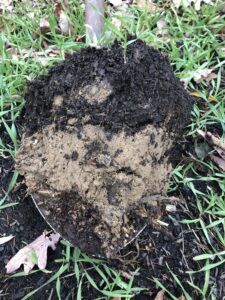
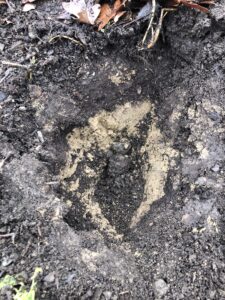

Finally, an analysis was done comparing the costs of construction for each new field, and was then translated into a dollar amount per 50 foot bed.
Our harvest data from the 2019 growing season for the cucumbers and leaf lettuce is shown below, including harvest dates and weights in pounds.
Hugelkultur Field Cucumbers
7/22: 3 lbs ; 7/27: 8 lbs ; 7/29: 24.5 lbs ; 8/1: 9.8 lbs ; 8/6: 28 lbs ; 8/13: 25.2 lbs ; 8/20: 37 lbs ; 8/22: 11 lbs ; 8/26: 14.1 lbs ; 9/3: 21.7 lbs
Total = 182.3 lbs
Soil Field Cucumbers
7/22: 1.78 lbs ; 7/24: 2.74 lbs ; 7/29: 5.9 lbs ; 8/1: 8 lbs ; 8/6: 7.4 lbs ; 8/12: 12.2 lbs 8/20: 16.6 lbs ; 8/22: 11.8 lbs ; 8/26: 4 lbs ; 9/3: 12 lbs
Total = 83.02 lbs
Hugelkultur Field Leaf Lettuce
7/18: 10 lbs ; 7/29: 11.2 lbs ; 8/1: 5.8 lbs ; 8/10: 3.5 lbs
Total = 30.7 lbs
Soil Field Leaf Lettuce
7/11: 6 lbs ; 7/24: 5.8 lbs ; 7/29: 10 lbs ; 8/10: 11 lbs
Total = 32.6 lbs
Both the weight and quality of cucumbers produced in the Hugelkultur Field exceeded that produced in the Soil Field in 2019. However, the amount of leaf lettuce produced in the Hugelkultur Field was slightly less than that produced in the Soil Field. There are a few factors that may have affected this. the Soil Field is near to a small wooded area of land, and so receives noticeably less sunlight during the morning hours. This reduced light could have affected plant growth, especially that of the cucumbers which were closer to the trees. Another variable between the two fields during 2019 wass that of irrigation. Since the Soil Field is directly adjacent to the previously existing Urban Farm, irrigation was run rather simply using a hose and sprinkler. The Hugelkultur Field is located across the street from the original city water hook up and so did not have access to irrigation during 2019. Here in Binghamton NY, we had slightly above average rainfall amounts during the 2019 summer months, but there were a few dry stretches during the end of June into the beginning of July that affected plant growth negatively in the Hugelkultur Field. This drying could have been made worse by having only a few inches of soil available for ground water storage and for roots to access.
Another issue that occurred with the straw bale beds that was not seen in the Soil Field was the weed pressure. The straw bales were bought from a farm in Willet New York which grows hops and grain crops for beer production. Therefore, this straw is mainly rye and barley and it was not entirely seed free. This led to most of the straw bales growing a dense cover of grass on the edges and in-between the vegetable beds. The grass was controlled with a weed trimmer, and was hand pulled in areas where it started to establish in the production bed.
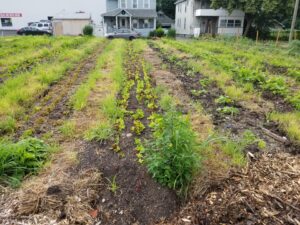
The winter between 2019 and 2020 killed most of the barley grass that was in the straw bales. The weed pressure shifted in 2020 to more usual farm weeds like crab grass, pigweed, and galinsoga. The Soil Field had strong weed pressure in 2019 due to weed seeds being brought in on unfinished compost. The poor drainage of the soil field led to nut sedge becoming a prevalent weed in 2020, thankfully this is easily controlled thru the stale seed bed technique and hand weeding.
Individuals working in the straw bale beds noted both positive and negative aspects of the design in 2019. One of the most commented on features was that of a lack of sturdy footing. Not every straw bale is uniform in its density and some decayed, and therefore settled, much quicker than others. This led to a very uneven walking surface that was difficult for some individuals to navigate. The straw bales also did not have perfect right angles and so fit together with small gaps, some of which where big enough to step into and posed a risk of twisted ankles. It was also noted that without specific instructions as to the design of the field, most individuals initial reaction was to walk on the soil surface, not the straw bales. Some positive comments that were noted included the raised bed effect after the straw bales started to settle, as well as the softness of the straw bale surface while kneeling, and crouching during work. One last comment regarding the straw bales during 2019 is the fact that a nest of ground hornets was attracted to a section of the field, whether this was pure coincidence or a certain feature of the field that attracted them is undetermined.
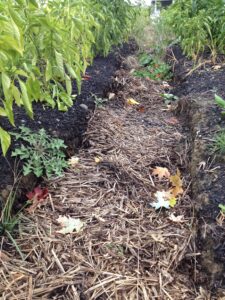
The 2020 growing season was the first full season with multiple successions of crops in both the Hugelkultur Fields and the Soil Field. The Soil Field was built into raised beds using a rotary plow attachment for our BCS. This gave us much better drainage than 2019. The Soil Field also had heavy weed pressure in 2019, this led us to fit in as many stale seedbeds as we could into the crop rotation in an attempt to reduce the weed seed bank. The early Spring clear plastic tarp on the Soil Field helped germinate seeds quickly towards this end, as well as heat the soil up sooner for planting in April. Crops chosen for planting in the Soil Field were done so based on 2019 observations. As the Soil Field was the most shaded on the farm, non fruiting plants and plants that did not prefer hot weather were prioritized. Our Siberian kale was planted in the Soil Field in mid April and looked fantastic all year until it was mowed down in November. Carrots and leaf lettuce were grown in the shadiest spots of the Soil Field in the fall and performed very well. Observing the 2019 season carefully informed better management practices in 2020 and led to better overall production outcomes.
The Hugelkultur Field planted with winter rye in 2019 required a black silage tarp to properly kill the cover crop in the spring. Winter rye can be very vigorous, and our power harrow cannot control it 100%. Our rotary plow, which is used to control winter rye elsewhere on the farm would not be practical in the Hugelkultur field because of the lack of soil in between the beds. The black silage tarp is a popular no-till method of field preparation and combined with our power harrow creates a wonderful seed and transplant bed. The potatoes grown in the Hugelkultur beds were the trickiest to manage as there is little to no soil in between the beds to hill the potatoes with. Again we would normally use the BCS with rotary plow attachment to hill. Instead we used buckets of compost followed by chopped leaves to hill our potatoes, which ended up not being as effective as the rotary plow. A portion of our potato crop was not adequately hilled which resulted in some green potatoes during harvest.
During 2020 the Hugelkultur beds became much more defined and easier for volunteers and youth to navigate them. After running the power harrow over the beds a thin layer of soil was thrown on top of the straw bales. This helped fill in holes and gaps in the paths and began to erase the uneven nature of them. The further addition of leaves and wood chips helped smooth and define the structure even more.
In regards to protecting individuals against lead exposure risks, we are much more comfortable with the Hugelkultur Field. This may change over time as the wood chips and straw bales decay, but currently they offer a large buffer between the soil growing surface and the original soil beneath. The depth of the Soil Field is still below the depth of our equipment, but the chance of the original soil being turned over is greater. During the harvest of carrots grown in the Soil Field workers ended up digging deeper than necessary and disturbing the original soil underneath in a small spot. Lead levels in our soil tests do not show an increase in lead concentration, but these levels will continue to be monitored on a yearly basis. As the soil is worked over the next few years if lead levels are seen to increase at all we can add more topsoil if deemed necessary. Yearly additions of compost and organic matter will hopefully continue to build this soil profile deeper and deeper, reducing the risk of disturbing the original soil underneath.
Finally the cost of construction for the two fields were compared including soil, compost, equipment rental, and labor.
| Soil | Compost | Equipment | Labor | Straw bales | Total Cost | Cost Per Bed | Cost per bed minus equipment | |
| Soil Field (20 beds) | $1073.21 | $948.00 | $208.45 | $101.5 | $0 | $2331.16 | $116.56 | $106.14 |
| Hugelkultur Field (17 beds) | $764.92 | $894.00 | $1101.59 | $304.5 | $1938.00 | $5003.01 | $294.29 |
$229.50 |
This cost analysis reveals the extra expense in the straw bale bed construction compared to that of the Soil Field. While the Soil Field used slightly more topsoil and compost, the total cost per fifty foot bed was $177.73 more in the Hugelkultur Field than that of the same size bed in the Soil Field. This extra cost is mainly in the cost of the straw bales and the equipment rental used to build the beds. Larger equipment was used in the construction of the Hugelkultur Field which was slightly more expensive per day than the equipment used in the Soil Field. As well, it look three full days of work to build the 17 beds in the Hugelkultur Field, compared to just one day of work for the Soil Field. Some farms may already have access to a bucket loader or equipment of this nature, and so the last column included shows the cost analysis per bed without the equipment rental fee. While this does reduce the cost per bed, ultimately the straw bales are the most expensive part of this method. Another option to reduce this cost is if older bales are purchased, perhaps at a discounted rate.
The main question to ask in regards to comparing these two field building methods, is whether the benefits of extra organic matter and a deeper field profile in the Hugelkultur Field is worth the added costs of materials and construction. It can be assumed that the health and fertility of the Hugelkultur Field will outpace that of the Soil Field in the long term as the extra organic matter of the wood chips and straw bales decay feed the soil micro-biome.
This project sought to explore an alternative method of building a vegetable production field from scratch. This was accomplished by comparing two new production fields at the Binghamton Urban Farm. A Soil Field, which was constructed with screened topsoil, purchased compost, and leaves acquired from the city of Binghamton, was compared to a Hugelkultur Field, which was constructed with locally produced straw bales, wood chips, and manure, as well as screened topsoil and purchased compost. Both of these fields produced marketable yields of vegetables during the 2019 season and allowed the Binghamton Urban Farm to add 10 new CSA shares to it's distribution, as well as provide vegetables to a new farmers market in downtown Binghamton. As the Binghamton Urban Farm continued to expand in 2020, we added 15 more CSA shares, along with new restaurant customers, and a new on-farm vegetable stand. The Hugelkultur and Soil Fields became the backbone of our production space, as our oldest production field was turned into a new hoop house and a small solar array.
During 2019 the Hugelkultur field was found to produce many more cucumbers, but a relatively equal amount of leaf lettuce. Other field variables were observed such as hours of full sun and water availability, which may have altered these results. The ease of working in the straw bale beds was seen to have many positives and negatives. The comfort of kneeling, crouching, and reaching into the straw bale beds was much nicer than that of the conventional beds, however, walking up and down the aisles on top of the bales was characterized by unstable footing, and a large variability in firmness during 2019. In 2020 this variability was largely erased as more organic matter and mulch was added.
Finally, the price per fifty foot bed was much higher for the straw bale beds as compared to the conventional beds. This was mainly due to the added cost of the bales themselves and the extra time requiring more hours of equipment rental.
Following the second season of growing in both the Hugelkultur and Soil fields better conclusions can be drawn about which field construction style is preferred. The ideal field I believe would be a combination of the two designs. The wood chips are the most beneficial aspect of the Hugelkultur Fields, which help create the excellent drainage, raise the growing surface, and will slowly breakdown and feed the soil there. Wood chips are also oftentimes free. I would first use a bulldozer or tractor to cover the entire field to be developed with as many wood chips as possible, at least 6 inches. Then using a bucket loader I would lay out strips of a soil and compost blend at least 8 inches deep to form the growing bed. This design would eliminate the expensive straw bales, while retaining the benefits of the Hugelkultur design. Care would need to be taken to not incorporate the wood chips into the soil mix, as this could have a negative effect on available nitrogen.
Education & Outreach Activities and Participation Summary
Participation Summary:
The model of the Binghamton Urban Farm is not only that of a productive market garden, but that of an educational farm as well. This fact made education and outreach easier than it might not have otherwise been. During the year of 2019 we had numerous school groups from all ages tour our straw bale beds, not to mention the dozens of volunteers we host every year, and the hundred and fifty people that attend our farm to table Summer supper.
The Covid-19 pandemic caused a massive shift in the way the Urban Farm operated in 2020 though. We still had volunteers and community members visiting the farm, just in lower numbers. Our school group tours became virtual, and our workshops were held online as well. In January 2021 Cornell's Small Farms Quarterly published an article written by Kyle, titled "Healthy soil for Urban Farm production: building from scratch" which focused on this project, Healthy Soil for Urban Farm Production_ Building from Scratch - Cornell Small Farms. Also in January 2021 Kyle presented at the NOFA-NY winter conference on this project.
Learning Outcomes
This project increased my awareness and knowledge of lead risks within the Urban Environment. My attitude towards building healthy soil has also changed. In the future, I believe burying wood chips underneath the topsoil will have a positive effect on soil health in the long run. This is free organic matter that is produced in bulk by most municipalities. Why not leverage this to our advantage as farmers?
Project Outcomes
The expansion of the Binghamton Urban Farm growing space has allowed us to increase our CSA and restaurant sales, provide produce to a new downtown Binghamton farmers market, and start an on-farm vegetable stand. After receiving our SARE grant funding we also were awarded $20,000 from the city of Binghamton to help fund the Binghamton Urban Farm's expansion. The Urban Farm's expansion has also prompted us to expand our Grow Binghamton Youth program. This past year we hired more youth than any other year, as our capacity continues to expand we have more opportunities to provide meaningful work and learning experiences for our high-school aged employees.
This project was very successful in my mind. Utilizing the expansion of the Binghamton Urban Farm we explored different methods of vegetable field development from a blank slate of compacted ground to a productive market garden. While there were too many variables between the Hugelkultur and Soil fields to truly compare our harvest data the lessons learned are from direct observations. The increased drainage and raised growing surface are the initial benefits of Hugelkultur design. The increased organic matter may turn out to be a long term benefit which is beyond the scope of this project. The long term fertility increases from this organic matter could lead to a production potential that outweighs the initial cost of the straw bales and the construction of the field.
With the knowledge gained from this project I would attempt a third field design which eliminated the straw bales, and only utilized the wood chips buried underneath. I believe a thick layer of wood chips, with strips of topsoil and compost laid out into beds, would have all of the benefits of the Hugelkultur field without the cost of the straw bales.
The knowledge and experience from this project would be most useful for other urban farmers or gardeners seeking to develop new productive spaces. Hugelkultur techniques could also be applied by municipalities and other land owners to enhance ecosystems in marginal zones. The city of Binghamton has an excessive amount of wood chips and burying these in certain areas could help improve soil quality to mitigate flooding, increase biodiversity, beautify landscapes, and even help trap carbon in the soil helping to balance the carbon budget of our urban spaces.